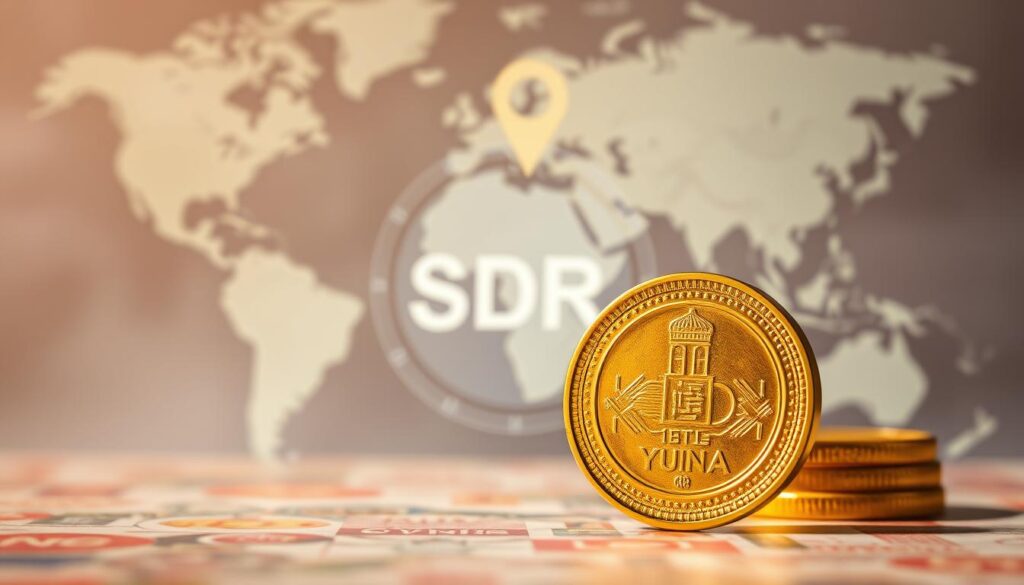
The history of money in China goes back over 3000 years. It started in the Neolithic age. This long journey has shaped the Yuan into what we know today.
The Renminbi, or Yuan, has seen big changes. These changes have greatly influenced financial transformation in China. Knowing how the Yuan developed helps us understand its role in China’s economy.
Key Takeaways
- The history of Chinese currency is over 3000 years old.
- The Yuan, or Renminbi, has undergone significant reforms.
- Understanding the Yuan’s development is crucial for understanding China’s economy.
- The Yuan’s evolution has impacted China’s financial transformation.
- The future of the Yuan is closely tied to China’s economic prospects.
The Ancient Origins of Chinese Currency
China has used different kinds of money for thousands of years. This shows how its economy and culture have grown. The story of Chinese money is interesting, from simple items to complex systems.
From Cowrie Shells to Bronze Coins
In ancient China, the Shang dynasty used cowrie shells as money. Later, the Zhou dynasty brought in bronze coins and other metal items. These early monies helped trade grow and showed the culture and economy of their times.
Paper Money Innovation in the Tang and Song Dynasties
The Tang and Song dynasties introduced paper money. The Tang started with paper receipts for merchants. The Song dynasty made the first official paper money. This big change made money easier to use and helped create today’s paper money.
Creating paper money was a big step for China’s economy. It showed the country’s ability to change and grow with its economy.
Imperial to Republican Era: Currency Transitions
The shift from imperial China to the Republican era was a big change in currency history. This time saw big changes in money, showing changes in society and economy.
Late Qing Dynasty Monetary System
In the late Qing dynasty, China had a complex money system. It used both silver and copper for money. The silver standard was for big deals, and copper coins for daily shopping. But, the values of silver and copper changed a lot, making money unstable.
The Qing government tried to make money easier by introducing new coins. But, the system was still hard to use. Also, foreign silver dollars became common, making money even more complicated.
Republican China’s Currency Challenges
When the Qing dynasty fell in 1911 and the Republic of China started in 1912, money problems grew. The new government had trouble making one money for everyone. Different places had their own money, causing money trouble.
- There was no central bank to help make money the same everywhere.
- Money value dropped a lot, making people lose trust in money.
- Using money from other countries in some places made things even harder.
Even with these problems, the Republican era helped set the stage for better money systems later. It showed the need for one stable money system. This led to the creation of the Renminbi (RMB) as China’s official money.
The Birth of the Modern Yuan (1949-1978)
In December 1948, the People’s Bank of China introduced the renminbi. This was a key step towards the modern yuan. It was part of a larger effort to stabilize and unify China’s economy after years of conflict.
Establishment of the Renminbi After 1949
The introduction of the renminbi was a crucial step in establishing a unified currency system in China. The renminbi replaced the various currencies issued by different regions and factions, bringing much-needed stability to the economy.
- Unification of currency
- Establishment of the People’s Bank of China as the central bank
- Initial steps towards a planned economy
The new currency was part of a broader set of economic policies aimed at rebuilding China after decades of war. The renminbi was introduced in December 1948, ahead of the official founding of the People’s Republic in 1949.
Currency Policies During the Maoist Era
During the Maoist era, China’s currency policies were heavily influenced by the political and economic ideologies of the time. The government implemented strict controls over the economy, including the currency, to achieve its socialist goals.
- Strict currency controls to prevent speculation
- Use of currency as a tool for economic planning
- Efforts to reduce dependence on foreign currencies
The currency policies during this period were aimed at supporting the state’s economic objectives. These included rapid industrialization and the collectivization of agriculture.
The establishment of the modern yuan and the currency policies during the Maoist era laid the foundation for China’s future economic developments. These early steps were crucial in shaping the country’s economic landscape.
China Currency Evolution Through Economic Reform
Deng Xiaoping’s economic reforms changed China’s currency management a lot. These changes helped turn China’s planned economy into a market-based one.
Deng Xiaoping’s Opening and Currency Changes
Deng Xiaoping started his economic reforms in the late 1970s. These reforms changed China’s currency system a lot. They aimed to open China’s economy to the world and boost growth.
Key aspects of the reforms included:
- Decentralization of economic decision-making
- Introduction of market mechanisms
- Encouragement of foreign investment
These changes made China’s currency, the Renminbi (RMB), more flexible. It also made the RMB stronger globally.
Dual Exchange Rate System (1980s-1994)
In the 1980s, China introduced a dual exchange rate system. This system had an official rate and a market rate.
The dual exchange rate system was characterized by:
- An official rate for certain transactions
- A market rate for other transactions
This system helped China move towards a market-based exchange rate. It also let China control its currency in some ways.
The dual exchange rate system was key in China’s economic shift. It helped manage the currency during big economic changes.
The 1994 Currency Reform: A Watershed Moment
The 1994 currency reform was a key moment in China’s economic history. It unified exchange rates and set up a foreign exchange market. This change shaped China’s economy.
The reform had two main parts. It unified exchange rates and created a foreign exchange market. Unifying exchange rates made it easier for businesses to deal with international trade.
Unification of Exchange Rates
Before 1994, China had a complex exchange rate system. This reform changed it to a single, managed float system. It made foreign exchange clearer and more efficient.
- Simplified foreign exchange transactions
- Improved transparency in exchange rates
- Enhanced the credibility of the Renminbi (RMB) internationally
Establishment of the Foreign Exchange Market
The 1994 reform also set up a foreign exchange market. This market let banks and financial institutions trade foreign currencies. It made foreign exchange transactions more liquid and efficient.
- Facilitated the trading of foreign currencies among banks
- Improved the efficiency of foreign exchange transactions
- Contributed to the development of a more sophisticated financial system
The 1994 currency reform was a watershed moment in China’s economic history. It was a big step towards a more market-oriented economy. It helped China join the global economy.
Yuan During the Asian Financial Crisis

China’s response to the Asian financial crisis was key. Its non-devaluation policy helped keep the region stable.
The crisis hit many economies hard in 1997. China chose not to devalue the yuan. This move kept investors confident and helped the region’s economy.
China’s Non-Devaluation Policy
China’s decision not to devalue the yuan was a big deal. It aimed to keep the region’s economy stable. By not devaluing, China avoided a race to the bottom.
This choice was widely praised. It showed China’s commitment to stability.
“China’s commitment to not devaluing its currency was a crucial factor in preventing the crisis from worsening,”
highlighting China’s role.
Strengthening Financial Stability
After the crisis, China worked to make its finances stronger. It introduced reforms and improved its financial rules.
These steps paid off. Here’s how:
| Year | Financial Stability Index | Currency Stability |
|---|---|---|
| 1997 | 60 | Stable |
| 1998 | 65 | Stable |
| 1999 | 70 | Strengthened |
The 2005 Exchange Rate Reform and Its Aftermath
China’s 2005 exchange rate reform started a new chapter in its monetary policy. It introduced a managed floating exchange rate system. This change made the Renminbi (RMB) more flexible and market-responsive.
The reform aimed to break free from the dollar peg, which had been in place since 1994. This peg made China’s economy too dependent on the US dollar. It limited China’s ability to set its own monetary policies.
Moving Away from the Dollar Peg
The 2005 reform was a big step for China. It moved to a managed floating exchange rate system. This system lets the RMB float against a basket of currencies, not just the US dollar.
- The RMB was revalued by 2.1% against the USD.
- A managed float was introduced, allowing the RMB to fluctuate within a narrow band.
- The exchange rate was to be determined with reference to a basket of currencies.
Managed Floating Exchange Rate System
The managed floating system gave China more control over its monetary policy. It let the People’s Bank of China (PBOC) set the exchange rate. But it also allowed for some market-driven changes.
Key features of the managed floating exchange rate system include:
- The PBOC sets a daily reference rate for the RMB against the USD.
- The RMB is allowed to float within a certain band around this reference rate.
- The band has been gradually widened over time to increase flexibility.
Global Financial Crisis Response
During the 2008 global financial crisis, China’s system proved effective. The PBOC could implement policies to stabilize the economy.
The crisis showed the value of a flexible exchange rate mechanism. China’s ability to manage its exchange rate and implement stimulus packages helped it better than many other countries.
The 2005 exchange rate reform and the managed floating system have been key to China’s economic growth. These changes have increased monetary policy flexibility. They have also helped China face global economic challenges effectively.
Internationalization of the Renminbi
The renminbi’s international role has grown a lot in recent years. This growth includes several key areas. These are offshore RMB markets, currency swap agreements, RMB use in international trade, and the Belt and Road Initiative.
Offshore RMB Markets Development
Offshore RMB markets are key to the renminbi’s global role. They let people trade and hold RMB outside China. This makes it easier to use in international deals.
Hong Kong, London, and Singapore are major centers for this. They have seen a big increase in RMB assets and liabilities.
Currency Swap Agreements
China has made currency swap deals with over 40 countries. These deals help settle trade and investment in RMB. They are important for RMB’s role in global trade.
These agreements include big players like Japan, South Korea, and the UK.
RMB in International Trade Settlement
More and more international trade is settled in RMB. This is because of China’s big trade volumes and efforts to make RMB a global currency.
A lot of China’s trade is now in RMB. This reduces the need for USD and other currencies.
Belt and Road Initiative Currency Strategy
The Belt and Road Initiative (BRI) has helped the renminbi a lot. The BRI involves big investments in many countries. Many of these countries use RMB for financing.
China aims to use RMB more in cross-border deals through the BRI. This boosts its global use.
| Initiative | Description | Impact on RMB Internationalization |
|---|---|---|
| Offshore RMB Markets | Development of RMB markets outside China | Increased global RMB liquidity |
| Currency Swap Agreements | Agreements with countries to facilitate RMB trade | Promoted RMB use in international trade |
| RMB in International Trade Settlement | Increasing use of RMB for trade transactions | Reduced reliance on USD |
| Belt and Road Initiative | Promotion of RMB for BRI project financing | Enhanced RMB global presence |
The Yuan’s Inclusion in the IMF’s SDR Basket

The IMF’s decision to include the yuan in the SDR basket in 2016 was historic. It recognized China’s currency as a major global currency.
Significance of the 2016 Milestone
The yuan’s inclusion in the SDR basket was a big deal for China. It showed the yuan’s growing role in global trade and finance. This move was a sign of trust in China’s economic reforms and openness to financial change.
The SDR basket is a key unit by the IMF. It includes major currencies for international deals. Adding the yuan meant it would join the US dollar, euro, yen, and pound sterling for global transactions.
The implications of this inclusion were big:
- More global acceptance of the yuan
- Better liquidity in international markets
- Potential for less US dollar use
Requirements and Preparations for Inclusion
To join the SDR basket, the yuan had to meet IMF criteria. These included:
- Being widely used for international deals
- Being freely usable for international transactions
China worked hard to meet these standards. It made its foreign exchange market more open and relaxed capital controls. The government also made the yuan more convertible and usable globally.
These steps helped the yuan join the SDR basket. They also set the stage for the yuan to become a key global currency. The 2016 milestone was a big step for China on this journey.
Digital Yuan: China’s CBDC Innovation
The digital yuan, also known as e-CNY, is China’s big move into central bank digital currency (CBDC). It’s part of China’s plan to update its financial system and make transactions smoother.
Development and Testing of the e-CNY
China started working on the e-CNY in 2019. They tested it first to see how it works and how people like it. The e-CNY is like digital cash, easy to use and keeps your money safe like cash does.
They tested it in many cities and different ways to make sure it’s strong. The People’s Bank of China (PBOC) and banks worked together to make it better and safer.
Technical Infrastructure and Design
The e-CNY uses blockchain technology for safe and clear transactions. It’s made to be easy for users, fast, and can be used in many ways.
It’s built to handle lots of transactions at once. This is important for it to be used a lot, both in China and around the world.
Implications for Domestic and International Finance
The digital yuan changes things for money in China and worldwide. In China, it helps more people get bank services and makes money cheaper and easier to use. It also helps the government control money better.
Outside China, the digital yuan could help the yuan become more popular in trade and finance. This could challenge the US dollar’s leading role. How well the e-CNY works will show how it affects global money systems.
Current Challenges and US-China Currency Relations
The current state of US-China currency relations is filled with challenges. These issues affect China’s economy and the global financial system.
Currency Manipulation Allegations
The US often accuses China of currency manipulation. This gives China an unfair trade advantage. Currency manipulation allegations are a big point of contention.
- The US Treasury Department has called China a currency manipulator before.
- China says its currency policies are for financial stability, not unfair trade.
- This has caused tension and talks between the two countries.
Trade War Impact on Exchange Rates
The trade war between the US and China has affected exchange rates. The trade war has caused the yuan’s value to change against the US dollar.
- US tariffs on Chinese goods have made the yuan cheaper.
- China’s actions in response to tariffs have also changed exchange rates.
- The uncertainty in trade talks has made currency markets more volatile.
Capital Controls and Convertibility Issues
China’s capital controls and the yuan’s convertibility are big issues. Capital controls help China manage money coming in and out. But they affect investors and the global market.
- These controls have big implications for investors and the global market.
- The yuan’s limited convertibility affects its use in international deals.
- China is trying to make the yuan more international, but it’s tough.
The challenges in US-China currency relations show how complex their economic ties are. To solve these issues, both countries need to work together and understand each other better.
Conclusion: The Future Trajectory of the Yuan
The yuan’s future is linked to China’s economic changes and its goal to make the renminbi global. China’s economy is growing, and this affects the yuan’s value. Both local and worldwide factors play a part.
The yuan has become more important in international trade and finance. Being included in the IMF’s SDR basket in 2016 was a big step. This shows its growing role worldwide.
The yuan’s future will depend on China’s economic balance and financial stability. The digital yuan, or e-CNY, is also key. It will help shape the yuan’s future.
The yuan is set to play a bigger role in the global economy. Knowing about the yuan’s growth and future is vital. It matters for investors, policymakers, and anyone watching the global economy.
FAQ
What is the history of Chinese currency?
Chinese currency history starts with cowrie shells. Then, bronze coins were introduced. Later, paper money came during the Tang and Song dynasties.
What was the significance of the 1994 currency reform in China?
The 1994 reform unified exchange rates. It also set up the foreign exchange market. This was a big step for China’s economy.
How did China’s currency policies evolve during the Maoist era?
In the Maoist era, China had a planned economy. It also had a fixed exchange rate system. These policies shaped China’s economy.
What is the current status of the renminbi’s internationalization?
The renminbi is becoming more international. Offshore RMB markets and currency swap agreements are growing. It’s also used in international trade and the Belt and Road Initiative.
What was the impact of the 2005 exchange rate reform on China’s economy?
The 2005 reform changed China’s exchange rate system. It moved from a dollar peg to a managed floating system. This had a big impact on China’s economy and trade.
What are the implications of China’s digital yuan for domestic and international finance?
The digital yuan could change China’s finance. It could affect payment systems, financial inclusion, and cross-border transactions. This has big implications for both domestic and international finance.
How did China respond to the Asian financial crisis?
China didn’t devalue its currency during the crisis. It worked to strengthen its financial stability. This helped protect its economy.
What is the significance of the yuan’s inclusion in the IMF’s SDR basket?
The yuan’s inclusion in the IMF’s SDR basket in 2016 was a big deal. It shows the yuan’s growing role in the global financial system.
What are the current challenges in US-China currency relations?
US-China currency relations face challenges. These include currency manipulation claims, the trade war’s impact, and issues with capital controls and convertibility.
How has the renminbi’s value changed over time?
The renminbi’s value has changed due to economic reforms and exchange rate policies. Global economic trends have also played a role, affecting its value against other currencies.
What is the future trajectory of the yuan?
The yuan’s future depends on China’s economic reforms and its global integration. It will also be influenced by global challenges and opportunities.

Adam G
This post was created by Adam G, a seasoned financial writer with a passion for explaining currency exchange and market movements

1 thought on “China Currency Evolution: History, Reforms, and Future of the Yuan”